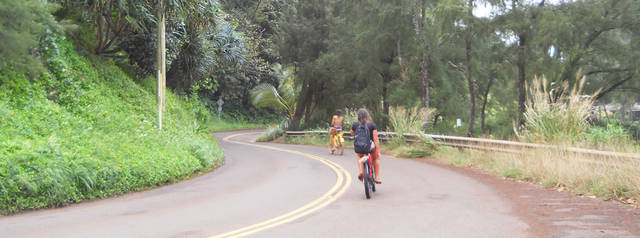HAENA — Haena resident Elsa Almaraz, who has lived in Haena for over 35 years, was not surprised to recently learn about the extended date of the Kuhio Highway reopening on the North Shore.
She was even less surprised after seeing a video shown in Haena across from the beach park.
“(Seeing) about 20 waterfalls cascading upon the road after only 10 minutes of hard rain was sobering. You cannot have waterfalls on your roads,” she said.
It had been hoped the highway might initially reopen in October following the April floods that washed out sections and forced its shutdown to the general public. But that’s now not expected until sometime in, at best, early 2019, and likely later. Much later.
Living in Wainiha and Haena these days, after the flood, has its pros and cons. Many people have mixed feelings about the changes they’ve been experiencing.
The recovery continues; many people are still fixing their homes and face other economic hardships.
Almaraz is partially relieved but also concerned.
She said many members of the community have to work on that side of the road, and have children.
“The convoy is inconvenient and stresses most of us out when we have to rush or worry about catching it or risk missing it,” she said. “We often are forced to cut visits or appointments short in order to make the convoy.”
She likes the idea of people, animals and nature being able to get a break from the normal hustle and bustle, calling it “a throwback to Old Hawaii days.”
But she is not happy with how the damaged Kuhio Highway is being handled. She said scientists and are on record saying that with the increased climate changes, people should expect more road damage and repairs.
“The only real long-term solution will be to reroute the road and that is said to cost billions of dollars,” Almaraz said.
If rerouting the road can be done, she feels that is the best solution. At least a bypass road for emergency use should be created.
It’s been about six months since Haena and Wainiha have been separated from the rest of the island. Since then only residents or people with approved permits have been able to pass through the stop point at Waikoko. Access is provided via a single-lane vehicle convoy system, which operates on specific time schedule throughout the week.
Haena resident Gregg Fraser, owner of Opakapaka Grill and Bar, is most concerned with what happens after the road reopens.
Fraser said what needs to be done is, “initiate, organize, come together and facilitate the master plan for Haena State Park. All of this time they could have been working on it, and putting it in place, and controlling the amount of vehicles that come in here, and make sure that everyone has got the right mindset for Haena State Park and Ke’e Beach.”
Vehicle and people traffic can be effectively controlled at Haena State Park in the future, Fraser said, if well managed. He points to other parks in Hawaii, including Hanauma Bay and Pearl Harbor on Oahu, as models for regulating the flow of vehicle and visitor traffic.
“It’s a ‘one way in, one way out’ single-lane road to get there. In Haena it is the same way. So why can’t you do the same thing in Haena?” Fraser said. “Once the parking lot’s full, we can shuttle a handful of people down and then shuttle them back out to wherever they are parked.”
When it comes to the single-lane bridges on the highway leading up to Waikoko from the north end of Hanalei, Fraser would like to see them left alone.
Haena resident Janet Mello, owner of the Wainiha General Store, or Last Chance, said the sooner the road opens, the better.
Mello closed the general store for a couple months, planning on reopening when the road reopened, but instead started back up early.
“The community is the reason I’m hurrying to open back up,” she said “It’s more for their benefit than mine. Our community out here really needs a little store.”
Haena resident Debbi Woodford said of the extended date for the road reopening: “I think that people need to stay positive.”
Woodford is happy to see kids and people riding their bikes and horses enjoying their freedom walking around town.
Also, any extra time that needs to be taken to repair the road properly is good, and completion of road repairs should not be rushed, she said.
“I think everyone is doing the best they can,” she said.
•••
Monique Rowan is a Wainiha resident who occasionally writes about the North Shore for The Garden Island.



Billions of dollars??? Do people ever question what they are told? It is 7 miles. Just Google “the average cost of road construction in usa”. Who came up with this number…the people who bid on the Honolulu rail project?
If climate change is coming, taxpayers shouldn’t spend a nickel more fixing the roads and bridges in North Shore, let alone build a bypass. That low-lying ground is a Tsunami death trap anyway
Aloha Kakou,
Wainiha and Haena could cecede from Kaua’i and call their Ahupuaa Newhau.
Charlie
Why should the rest of us support hundreds of millions in spending for this? Haena people want the road fixed but they don’t want anyone else out there. Add to that the fact that climate change and erosion will make this an ongoing problem. The work that is going on now is not a solution, it’s a band-aid. Yes, rerouting the road mauka is a solution but far too expensive. How about just making Haena a park, with access by foot, bike and service vehicles?
kudos to north shore residents to pissing off even other locals on the same island!